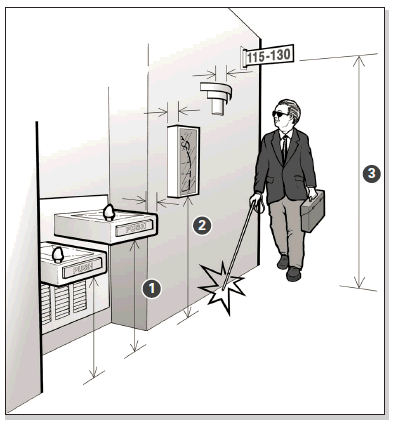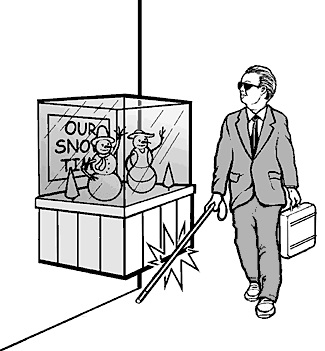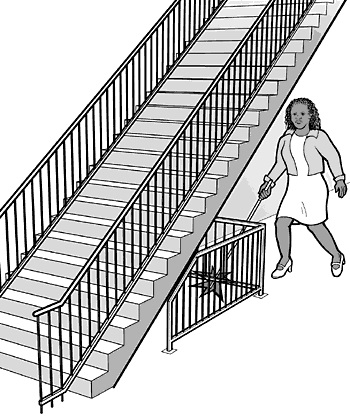Part 2. Typical Issues for Voters Who are Blind or Who Have Low Vision
People who are blind or have low vision may walk along any route to access the voting area, not just the accessible routes. That means pedestrian routes open to voters serving or leading to the voting area, such as hallways, corridors and the voting space, must be free of objects that cannot be detected by a person who is blind or visually impaired. Objects that are wall-mounted, that project into a pedestrian route from the side, or that are overhead must be located so that voters who are blind or who have a visual impairment will either detect the objects before they run into them or safely pass under them. These routes must be free of overhanging objects that are less than 80 inches above the floor and side objects that protrude into the route more than 4 inches when the bottom of the object is more than 27 inches above the floor. Items to watch for include wall-mounted fire extinguishers and wall-mounted display cases when the bottom is more than 27 inches above the floor, wall sconces and light fixtures that protrude more than 4 inches off the wall, and open staircases, exit signs, overhead signs, banners, and arched doorways that are lower than 80 inches above the floor.
The following checklist applies to pedestrian routes serving or leading to the voting area.

Overhead and wall-mounted objects that may be hazards along a pedestrian route.
Notes:
1. Wall-mounted drinking fountains are a hazard when the front projects more than 4 inches beyond the wall and the bottom is more than 27 inches above the floor.
2. Wall-mounted objects cannot project more than 4 inches beyond the wall if the bottom is not in the cane-detectable area below 27 inches off the floor.
3. Overhead objects must be at least 80 inches off the floor.
E2-1. Are pedestrian routes leading to or serving the voting area free of objects that protrude from the side more than 4 inches into the route with the bottom of the object more than 27 inches above the floor? [ADA Stds. 4.4]
Note: These objects may be wall mounted or free standing. Items to check include wall-mounted fire extinguishers, light fixtures, coat hooks, shelves, drinking fountains, and display cases. If No, list the objects that are a hazard and their location. Placing a detectable object on the floor below each object may remove the hazard for election day.
Yes _____ No _____

If the bottom of an object is not more than 27 above the floor, it may extend an unlimited amount from the wall.
E2-2. Are pedestrian routes leading to or serving the voting area free of overhead objects with the bottom edge lower than 80 inches above the floor?
Yes _____ No _____
If No, list the objects that are a hazard and their location. Placing a detectable object on the floor below each object may remove the hazard for election day.
E2-3. If provided, are the interior stairs along these routes built so that people who are blind or visually impaired cannot hit their heads on the underside (i.e., protected with a cane-detectable warning or a barrier that prevents travel into the area with less than an 80-inch-high head clearance)? [ADA Stds 4.4.2]
Yes _____ No _____
Temporary Solutions for Election Day
Hallways and Corridors - Voters Who are Blind or Who Have Low Vision
Problem One:
Wall-mounted display case is a protruding object hazard because it is more than 4 inches from the wall and the bottom of the case is more than 27 inches above the floor.
Suggestion: Place a detectable object or skirting below the case. The bottom of the skirting or detectable object must be no higher than 27 inches above the floor.
Problem Two:
Ceiling or wall-mounted television monitor has less than 80 inches of clearance between the floor and the bottom of the unit.
Suggestion: Place a detectable object below the unit (no more than 27 inches above the floor) so a voter who is blind will not walk into the television.
Problem Three:
The bottom of a stair is open and voters who are blind or who have low vision can hit their heads on the underside of the stair.
Suggestion: Provide a detectable fence or other object so voters cannot walk under the stair.

A detectable fence placed under this stair keeps people from running into the bottom of the open stair.

User Comments/Questions
Add Comment/Question